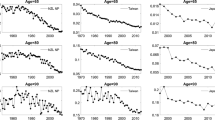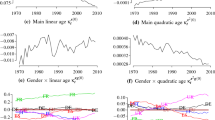Abstract
It is well known that accurate forecasts of mortality rates are essential to various demographic research topics, such as population projections and the pricing of insurance products such as pensions and annuities. In this study, we argue that including the lagged rates of neighbouring ages cannot further improve mortality forecasting after allowing for autocorrelations. This is because the sample cross-correlation function cannot exhibit meaningful and statistically significant correlations. In other words, rates of neighbouring ages are usually not leading indicators in mortality forecasting. Therefore, multivariate stochastic mortality models like the classic Lee–Carter may not necessarily lead to more accurate forecasts, compared with sophisticated univariate models. Using Australian mortality data, simulation and empirical studies employing the Lee–Carter, Functional Data, Vector Autoregression, Autoregression-Autoregressive Conditional Heteroskedasticity and exponential smoothing (ETS) state space models are performed. Results suggest that ETS models consistently outperform the others in terms of forecasting accuracy. This conclusion holds for both female and male mortality data with different empirical features across various forecasting error measurements. Hence, ETS can be a widely useful tool to model and forecast mortality rates in actuarial practice.



Similar content being viewed by others
Notes
Intuitively, a sophisticated univariate model makes the best use of univariate filtration. However, if cross-sectional rates cannot bring in additional useful information but only noise, the quality of multivariate forecasting will be compromised.
Age groups are selected to compare our results directly with those of Giacometti et al. (2012). A much wider range 0–100 is considered in “Australian mortality data: 0–100 years old, 10-step-ahead horizon, 1950–2011 and two-dimensionally smoothed rates” section. The complete results for such case are presented in the supplementary materials. Our conclusions derived in this paper consistently hold in that more comprehensive dataset.
Estimates can also be obtained using maximum likelihood estimation, as suggested by Renshaw and Haberman (2006).
As noted by Booth et al. (2006), the forecasting results are relatively insensitive to the choice of J, given that J is large enough. We have also considered cases when J = 6, 8 and 9. All of them lead to similar results.
We also consider using the original \(\ln {\kern 1pt} m_{x,t}\) with polynomial trends at order 2, as employed by Giacometti et al. (2012). Results are consistent and available upon request.
Among them, eleven cases are unstable and not preferred in practice (Hyndman et al. 2008).
For the trend component, an additional “damped” type (Gardner Jr and McKenzie 1985) is also considered for additive and multiplicative cases. Altogether, there are five different scenarios for trend: none, additive (damped) and multiplicative (damped).
Due to space limit, we only report the results of ages from 40 to 90 with a 5-year gap. Complete results are consistent and available upon request.
Despite that the filtration of univariate model is a subset of the multivariate model, the additional cross-sectional information is mostly noise for the mortality rates of interested age group. Hence, the performance of multivariate models may be even worse than the univariate counterparts.
A third DGP with LC model is also considered, which leads to consistent findings with those presented in the next subsections. Complete results can be found in the supplementary materials.
We present only the fitted results for ages 40–91 in this paper for comparison purpose. Complete results for ages 0–100 can be found in the supplementary materials. In all cases, our results lead to consistent conclusions.
From this subsection onward, all empirical results are used as robustness checks from different perspectives. As suggested by one of the anonymous referees, to avoid overloaded exhibits, we have presented all the relevant tables and figures in the supplementary materials.
As noted by Booth et al. (2002), there are structural changes in Australian mortality around 1970 and the resulting Lee–Carter kt has a kink in the trend. Therefore, we have checked the robustness for data ranging from 1971 to 2011 instead. Complete results are presented in the supplementary materials.
In order to fit the un-smoothed time pattern, here we only consider the ETS models with damped trends.
As the time pattern is still not smoothed, we only consider the ETS models with damped trends here.
Technically, when cross-correlations are insignificant, a multivariate model like VAR should reduce to its univariate form (AR). However, excessive number of parameters in VAR may lead to infeasible estimation. Sparse VAR (sVAR) proposed by Davis et al. (2016) is an effective solution in this regard. Using a LASSO-type penalty, irrelevant parameters are forced to be 0 in this model. We consider the sVAR(1) model in the supplementary materials. Although its results are generally better than those of VAR, ETS is still overall the most preferred model considering all investigated ages.
References
Bell, W. R. (1997). Comparing and assessing time series methods for forecasting age specific fertility and mortality rates. Journal of Official Statistics, 13, 279.
Booth, H., Hyndman, R., Tickle, L., De Jong, P., et al. (2006). Lee–Carter mortality forecasting: A multi-country comparison of variants and extensions. Demographic Research, 15, 289–310.
Booth, H., Maindonald, J., & Smith, L. (2002). Applying Lee–Carter under conditions of variable mortality decline. Population Studies, 56(3), 325–336.
Camarda, C. G. (2012). Mortalitysmooth: An R package for smoothing poisson counts with P-splines. Journal of Statistical Software, 50(1), 1–24.
Chatfield, C. (1997). Forecasting in the 1990s. Journal of the Royal Statistical Society: Series D (The Statistician), 46(4), 461–473.
Davis, R. A., Zang, P., & Zheng, T. (2016). Sparse vector autoregressive modeling. Journal of Computational and Graphical Statistics, 25(4), 1077–1096.
Du Preez, J., & Witt, S. F. (2003). Univariate versus multivariate time series forecasting: An application to international tourism demand. International Journal of Forecasting, 19(3), 435–451.
Gardner, E. S. (1985). Exponential smoothing: The state of the art. Journal of Forecasting, 4(1), 1–28.
Gardner, E. S., Jr., & McKenzie, E. (1985). Forecasting trends in time series. Management Science, 31(10), 1237–1246.
Giacometti, R., Bertocchi, M., Rachev, S. T., & Fabozzi, F. J. (2012). A comparison of the Lee–Carter model and AR-ARCH model for forecasting mortality rates. Insurance: Mathematics and Economics, 50(1), 85–93.
Girosi, F., & King, G. (2007). Understanding the Lee-Carter mortality forecasting method 1. Technical report, Rand Corporation, Santa Monica, CA.
Human Mortality Database. (2016). University of California, Berkeley (USA), and Max Planck Institute for Demographic Research (Germany), http://www.mortality.org. Accessed 1 Feb 2016.
Hyndman, R. J., & Khandakar, Y. (2008). Automatic time series forecasting: The forecast package for R. Journal of Statistical Software, 27(3), 1–22.
Hyndman, R. J., & Koehler, A. B. (2006). Another look at measures of forecast accuracy. International Journal of Forecasting, 22(4), 679–688.
Hyndman, R. J., Koehler, A. B., Ord, J. K., & Snyder, R. D. (2005). Prediction intervals for exponential smoothing using two new classes of state space models. Journal of Forecasting, 24(1), 17–37.
Hyndman, R., Koehler, A. B., Ord, J. K., & Snyder, R. D. (2008). Forecasting with exponential smoothing: The state space approach. Berlin: Springer.
Hyndman, R. J., Koehler, A. B., Snyder, R. D., & Grose, S. (2002). A state space framework for automatic forecasting using exponential smoothing methods. International Journal of Forecasting, 18(3), 439–454.
Hyndman, R., & Ullah, S. (2007). Robust forecasting of mortality and fertility rates: A functional data approach. Computational Statistics & Data Analysis, 51(10), 4942–4956.
Lee, R. D., & Carter, L. R. (1992). Modeling and forecasting US mortality. Journal of the American statistical association, 87(419), 659–671.
Makridakis, S., & Hibon, M. (2000). The M3-competition: Results, conclusions and implications. International Journal of Forecasting, 16(4), 451–476.
Ord, J. K., Koehler, A., & Snyder, R. D. (1997). Estimation and prediction for a class of dynamic nonlinear statistical models. Journal of the American Statistical Association, 92(440), 1621–1629.
Pegels, C. (1969). Exponential forecasting: Some new variations. Management Science, 15(5), 311–315.
Ramsay, J. O., & Silverman, B. W. (2005). Functional data analysis. Berlin: Springer.
Renshaw, A. E., & Haberman, S. (2003). Lee–carter mortality forecasting with age-specific enhancement. Insurance: Mathematics and Economics, 33(2), 255–272.
Renshaw, A. E., & Haberman, S. (2006). A cohort-based extension to the Lee–Carter model for mortality reduction factors. Insurance: Mathematics and Economics, 38(3), 556–570.
Taylor, J. W. (2003). Exponential smoothing with a damped multiplicative trend. International Journal of Forecasting, 19(4), 715–725.
Trefethen, L. N., & Bau, D. (1997). Numerical linear algebra (Vol. 50). Siam.
Wood, S. N. (2003). Thin plate regression splines. Journal of the Royal Statistical Society: Series B (Statistical Methodology), 65(1), 95–114.
Acknowledgements
We are grateful to the Macquarie University and Jiangxi University of Finance and Economics for their support. The authors would also like to thank Rob Hyndman, James Raymer and Hanlin Shang for their helpful comments and suggestions. We are also grateful for the valuable advice provided by the Editor (Santosh Jatrana) and two anonymous referees. The usual disclaimer applies.
Author information
Authors and Affiliations
Corresponding author
Electronic Supplementary Material
Below is the link to the electronic supplementary material.
Rights and permissions
About this article
Cite this article
Feng, L., Shi, Y. Forecasting mortality rates: multivariate or univariate models?. J Pop Research 35, 289–318 (2018). https://doi.org/10.1007/s12546-018-9205-z
Published:
Issue Date:
DOI: https://doi.org/10.1007/s12546-018-9205-z




